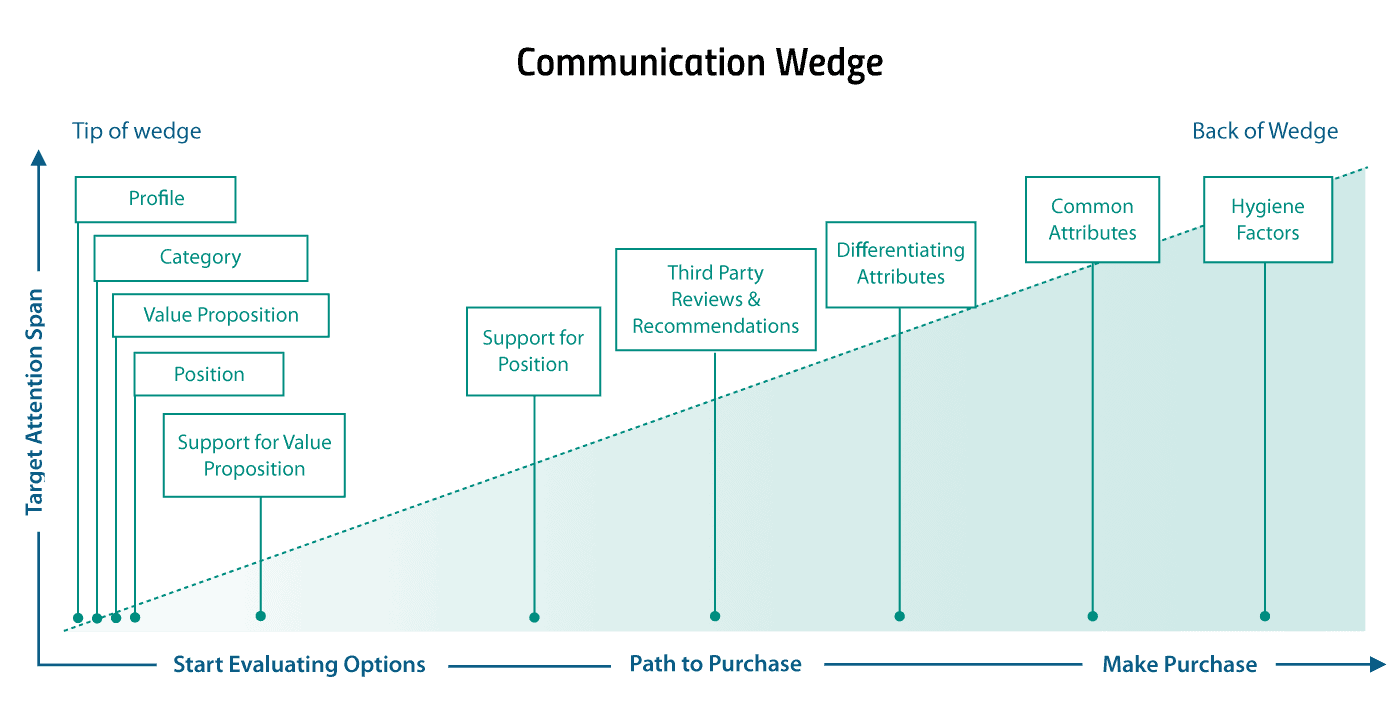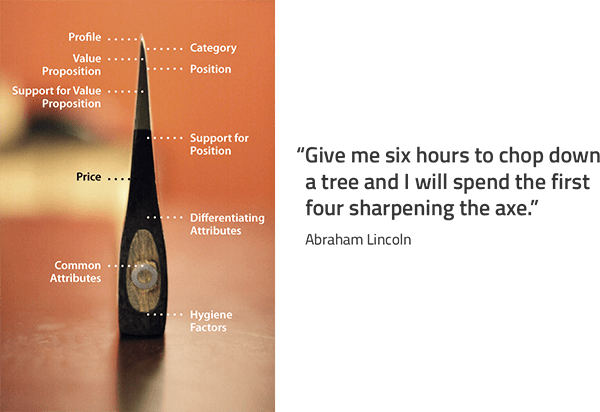TMI, or too much information, isn’t just a funny internet acronym. It’s the reason why many brands fail to engage online. When the message is a muddle of ill-conceived, poorly-timed features, benefits, and claims that mirror competitors’, it is often at odds with the way prospects make purchase decisions. This can make it difficult, or, in many cases impossible, for consumers to assess what the brand has to offer, what makes it different from other options, and/or if it can be trusted. All of which precludes the possibility of engaging, no less making a sale and creating a brand advocate.
How to tell your brand story well?
Approaching the market in this manner is a lot like trying to chop down a tree with the blunt end of the ax. It can be done, but it will require ten times the effort and, in marketing terms, that means ten times the budget. Duffy Agency would like to propose a better way: Focus on the information needs of your prospects during each step of the purchase process, then shape your brand communication to answer those needs. An easy way to envision this is to picture a wedge like the one illustrated below. The wedge is formed by the amount of time consumers are willing to spend with brands along the path to purchase. As long as your prospects continue to see value in the engagement, they will continue to invest more time in your brand along their journeys. The challenge with this wedge is that the most critical decisions are made at the tip of the wedge, where marketers have the least amount of time to make their case.
To succeed, your prospect’s interest needs to be sparked with a small amount of information at the start (the tip of the wedge) — if you ever hope to deliver the entire payload of features and benefits required to close the sale (the back of the wedge). The sharper the tip, the easier the conversion process is from one stage of the brand equity cycle to the next. That’s why you need to be very selective about what is said first. It should be clear, differentiating, highly relevant to the target, believable and, of course, true. It should also be communicated in about ten seconds.
The four gatekeepers to engagement in your story
Consider a new visitor to your website. You’ve succeeded in attracting their attention, but now your brand has a matter of seconds to answer four fundamental questions. These questions act as gatekeepers. The answers your brand provides will determine whether the prospect invests more time with your brand or moves on to your competitor’s site.
The four gatekeepers to prospect engagement:
- What are you?
Provide familiar cues to help prospects understand your brand’s category, and by extension the need it addresses, immediately. - Why should I care?
Single-out the one attribute of your brand that is most likely to influence your target’s value perception. - How do you compare?
Highlighting something that differentiates your brand’s offer from competing options. - Can I trust you?
Make sure your landing page(s) reflect a look and feel that your target will associate with a credible brand in this category.
These are the four gatekeeper questions that Duffy Agency will help you answer with this guide. Each will need to be answered within seconds of making contact. That doesn’t give you much time for flowing copy, data sheets, or explainer videos. What is necessary is to condense the answers down into a sort of consumer shorthand that will make it easy for the prospect to get the big picture of your brand from a very small amount of information. That shorthand is strategic marketing communication. We’ll show you how to use the four constructs below to convey the information necessary to hook prospects within the few first seconds online.
The four answers every brand needs to provide to prospects:
- CATEGORY answers “What are you?”
- VALUE PROPOSITION answers “Why should I care?”
- POSITION answers “How do you compare?”
- PROFILE answers “Can I trust you?”
An inexact science
At its core, strategic positioning and the related concepts covered in this guide are attempts to predict how consumers categorize, engage, evaluate, and choose among their options. The terms we define are constructs designed to help marketers see the world from their target’s perspective so they can communicate their offer in a manner that the target will best understand and respond to. Sounds very neat and tidy in theory.
In practice, however, it’s a lot easier to determine the correct category, value proposition, position, and profile for a particular brand and target audience than it is to speak about these topics in general terms. When marketers try to do so, the definitions usually seem vague, overly theoretical, and often contradictory. A quick Google survey of any of these terms will reveal as much. The reason a uniform model to determine the right category, value proposition, position, or profile for any brand can’t be produced is because there is no uniform way in which consumers categorize or evaluate their options.
So, take the definitions in this guide with a grain of salt. Use the processes outlined to focus your message online and engage your audience. But, bear in mind that the only people who really have that answer are your prospects and, provided you know how to ask them, they will never steer you wrong.
Testing your assumptions
Every marketing strategy is based on assumptions. As these assumptions are validated, risk for your business is reduced. In each chapter of this guide, Duffy Agency will encourage you to test your assumptions about your prospects to ensure their validity. This can be done in a number of different ways, i.e. desktop research, online surveys, phone interviews, focus groups, etc. We have found semi-structured, in-depth interviews with a small but representative sample of a brand’s target market to the be the most effective method for this type of investigation. Have a third party interview 10 – 20 prospects (at least three representatives from each target segment) along the lines recommended in this guide.
The reason using a third party is recommended is for the outside perspective brought into the process. That statement may sound suspect coming from someone who makes his living doing this type of work. You would be perfectly justified to ask, “Why not do it myself?” After all, you know your brand better than anybody, right? Yes, but when it comes to determining prospects’ perceptions related to your brand, that familiarity is actually a liability.
Like psychotherapy, dentistry, and marriage counseling, the do-it-yourself approach is not going to work even though you’re closest to the subject matter. What we actually pay psychotherapists, dentists, marriage counselors and brand-positioning consultants for is perspective. Their distance helps them provide a more objective assessment than you can achieve on your own.
So, find someone outside your organization who has experience in this type of research. Ideally, someone you trust to speak plainly about your brand. Because, as positioning expert Blair Enns explains, “No matter how hard you try, you can’t read the label from inside the jar.”
The purchase process begins when the prospect has decided on a solution and is evaluating options. But, it’s worth noting that the purchase process outlined above maps only half of the journey that the prospect takes leading up to a purchase. There are three steps — each of which provide marketers an opportunity to introduce themselves to prospects and preempt the purchase process to gain an advantage over competitors before. We call this the path to purchase. Understanding it is essential to succeeding with content marketing and online marketing efforts.
Purchase process vs Path to Purchase
The purchase process begins when the prospect has decided on a solution and is evaluating options. But, it’s worth noting that the purchase process outlined above maps only half of the journey that the prospect takes leading up to a purchase. There are three steps — each of which provide marketers an opportunity to introduce themselves to prospects and preempt the purchase process to gain an advantage over competitors before. We call this the path to purchase. Understanding it is essential to succeeding with content marketing and online marketing efforts.
Path to Purchase
The exact steps taken along this path will be different for every product. But, there are six characteristic phases that are used as a framework when mapping the behavior of prospects leading up to purchase. They are:
- Defining the problem
- Defining the solution
- Identifying providers of the solution
- Evaluating providers
- Deciding on a provider
- Making the purchase
Read more also about brand DNA model and find out how to create brand identity.






